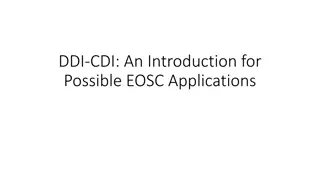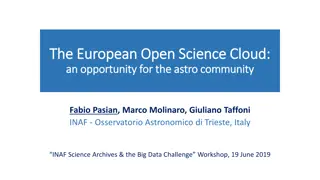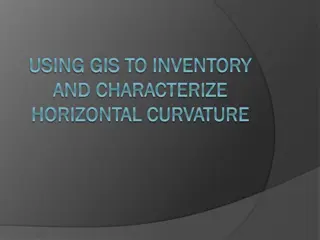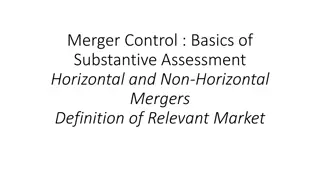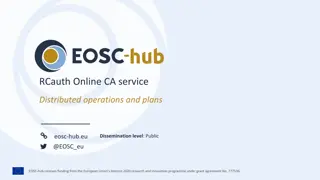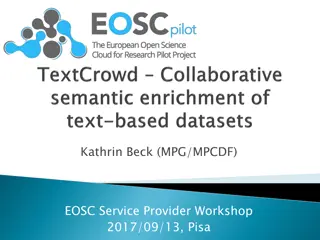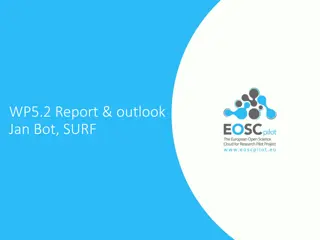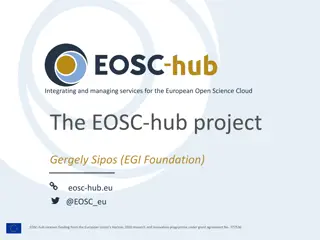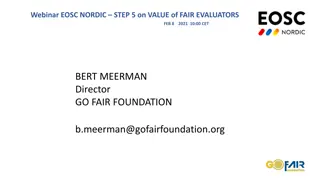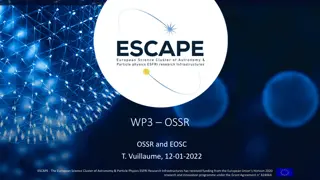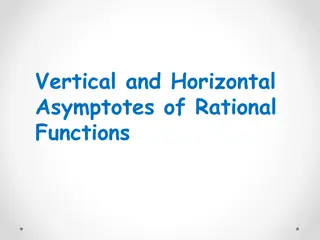Exploring EOSC Exchange Horizontal Services and Funding Perspectives
Exploring the EOSC Exchange's alignment with EGI business models, the set of federation services registered to EOSC, managed services for EOSC procurement, user perspectives on application workflow management, and funding perspectives for horizontal services. Key points include the importance of sustainability plans, clear revenue paths for application developers and data providers, and the complexity of cross-border funding for Member States.
Download Presentation

Please find below an Image/Link to download the presentation.
The content on the website is provided AS IS for your information and personal use only. It may not be sold, licensed, or shared on other websites without obtaining consent from the author. Download presentation by click this link. If you encounter any issues during the download, it is possible that the publisher has removed the file from their server.
E N D
Presentation Transcript
EOSC Exchange Alignment with EGI business models Ignacio Blanquer Universitat Polit cnica de Val ncia / EOSC-A DISCLAIMER: The opinions expressed in this presentation are solely those of the presenter.
EOSC Exchange: setting the scene (I) The set of federation services registered to the EOSC by RIs and clusters to serve the needs of research communities and the widening to the general public and private sector [1]. According to EOSC Future D2.9 - MVE EOSC Exchange functions - EOSC Data Transfer - EOSC Helpdesk as a Service - EOSC Research Data as a Service - Added Value EOSC Exchange functions - Compute Infrastructures and platforms - Computing services for multidisciplinary science. - Data archive, discovery and repository. - Catch-all repository. - Dashboards - Thematic specific services - Data providers and processing services - Semantic interoperability [1] https://eoscfuture.eu/wp-content/uploads/2022/12/EOSC-Future-WP2-TGB-D2.9-Co- designed-Architecture-Description-2022-01-14.pdf - - [1] https://data.europa.eu/doi/10.2777/492370
EOSC Exchange: setting the scene (II) - Managed services for EOSC Procurement: Managed Container Platform and Virtual Machine Services for the EOSC Exchange (Lot 2 - Infrastructure Services) - The EOSC Exchange is the set of services and other resources registered into EOSC by Service/Data Providers (such as e-Infrastructures, Research Infrastructures, Science Clusters, Commercials) to serve the needs of research communities and will widen its offering to the public and private sector. - Generic services and resources which target heterogeneous scientific domains and research communities are identified as horizontal services . The following horizontal services are procured for the EOSC Node. 1. Managed Container Platform Service Container Orchestration Container Management 2. Managed Compute (Virtual Machines) Infrastructure Service Compute/Storage Service Infrastructure Management 3. Managed Bulk Data Transfer Service High-volume data migration
User perspective - The Application Workflow Management (AWM) is a Lot 1 EOSC Core service that enables the researchers to deploy and compose virtual environments for scientific data. - EOSC Exchange horizontal resources clearly require funding. Application developers and data provider should find their revenue path too. Application marketplace Federated Data Data Request - Application Request Virtual Environment AWM Credits EOSC-Exchange Horizontal Resources
EOSC Exchange Horizontal services in the context of a federation such as EGI - Horizontal services are nationally or regionally funded - Funding the onboarding of services is a catalyser for the development of thematic services. - There should be clear sustainability plans beyond the onboarding period. EC should focus on the EOSC interaction layer. - Cross-borders funding is always complex for MS. Different models have been proposed - Centrally financed consumption of services. - Virtual access through better than invoicing. - Limitations beyond not-for-profit services. Combination of service procurement with research-oriented support. EGI provides a common federated structure to jointly provide offers. - - - -
EOSC Exchange community-specific services - Community-specific services cannot be procured as the horizontal IT services - Direct engagement of the community is needed. - International collaborations have their own sustainability plans. - The link to EOSC will bring - Cross-domain visibility and interoperability - Share best practices and EOSC core services - Federated AAI, PIDs, interoperability services - Jointly procure services - Especially storage and processing capabilities. - Jointly evolve core and shared services. - EOSC benefits will save innovation costs. - However, service usage comes with a cost - Public research data should not be a commercial good, but the service instead.
Conclusions - Different sustainability models should coexist as EOSC Exchange is a fairly heterogeneous component. Core IT services could come from procurement and research-specialised services could combine in-kind contributions. Innovation and operation should be closely coordinated to minimise replication of efforts. - -







